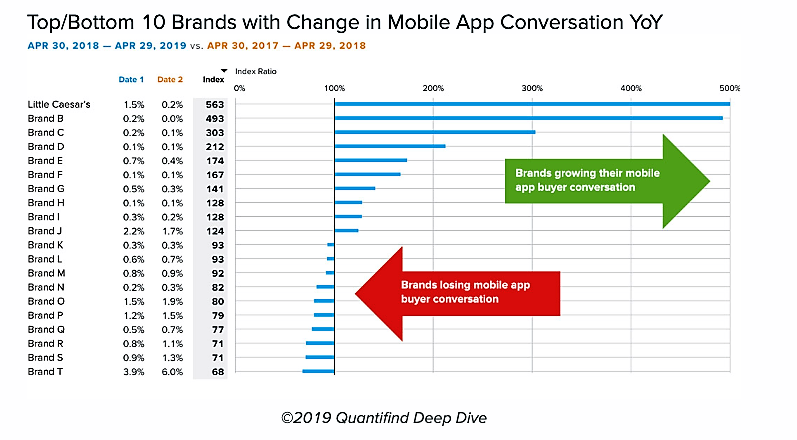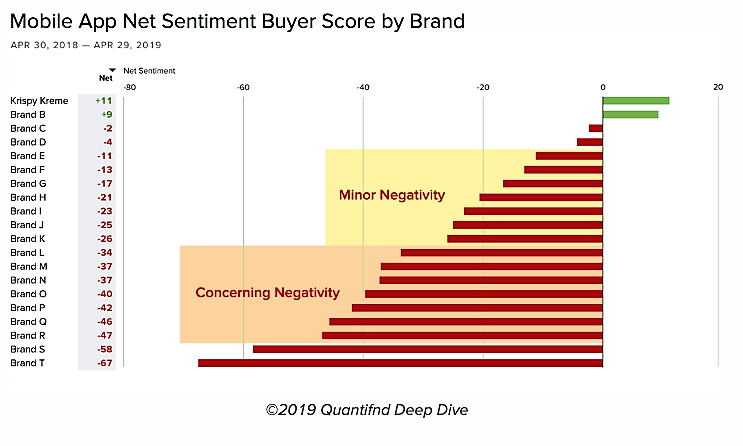Blog
The difference better apps can make to QSR brand loyalty
How can your QSR really drive business through its app? Read on for the latest findings on what works and what doesn't as provided through an AI analysis of brands' efforts by Quantifind.

June 12, 2019
By Paul O'Shea/Quantifind Director Customer Success
While core fundamental drivers, like craving and taste remain pillars that shore up customer loyalty for QSRs, mobile apps are emerging as potent players in this dynamic space. In fact, this largely phone-based customer connection tool may be the only way to drive sales frequency among the increasingly important younger demographic.
Proprietary machine learning/AI at Quantifind provides a look into real, un-aided consumer conversation to glean the signals that truly drive business, from those that simply generate inconsequential noise or buzz. In fact, by diving deep below the surface of unstructured data, Quantifind has found that the quality and effectiveness of mobile apps can be linked to significant revenue growth for restaurant brands.
 As this chart illustrates, conversation topics, including craving and taste, are more dominant in organic conversation or "buzz," while issues related to drive-through and mobile apps index much higher in buyer conversation, meaning those that are likely to drive business. This implies that these topics serve as more meaningful signals around revenue and warrant perfect execution to ensure a great customer experience and drive future brand loyalty.
As this chart illustrates, conversation topics, including craving and taste, are more dominant in organic conversation or "buzz," while issues related to drive-through and mobile apps index much higher in buyer conversation, meaning those that are likely to drive business. This implies that these topics serve as more meaningful signals around revenue and warrant perfect execution to ensure a great customer experience and drive future brand loyalty.
Chat on the App is 'on the up'
The next chart maps the growth of buyer conversations around mobile apps over the last two years, showing clearly that mobile apps within this vertical are talked about more frequently and are becoming more central to the dining decision-making process. QSRs that capitalize on this with up-to-date mobile app strategies are well positioned to win market share, while those that don't will fall outside this collective conversation, risking relevancy and popularity.
vertical are talked about more frequently and are becoming more central to the dining decision-making process. QSRs that capitalize on this with up-to-date mobile app strategies are well positioned to win market share, while those that don't will fall outside this collective conversation, risking relevancy and popularity.
Savvy restaurant brands are working to boost their mobile apps to meet consumers where they increasingly are -- on their phones. This investment pays off in a better consumer brand experience for customers who can reap rewards and other perks, as well as better data mining opportunities for brands seeking to grow overall understanding of their customers' behavior. These assets, in turn, inform future efforts around product development, messaging and media planning.
Also noteworthy is the fact that 55% of buyer conversations around mobile apps are conducted by women. Likewise, when looking at growth in mobile app conversations year-over-year, Generation Z--the under 21 cohort--present the greatest opportunity for targeted growth.
Still to be determined though are the identities of the brands that will best be able to detect these kinds of salient buyer signals underlying the mobile app conversation in order to capitalize on this critical new trend. Then, that question would be followed by another: How does your brand rate?
Doughnuts doing 'circles around the competition'
Quantifind also assessed buyer sentiment around the mobile apps of 20 of the 47 restaurant brands in our dataset with eye-opening results. Ninety percent of our assessment pool showed a Negative Net Sentiment about the apps, meaning the overwhelming majority fall on the wrong side of consumer expectations.
Krispy Kreme headed up the elite group of just two that scored a Positive Net Sentiment. The rest of the pack was distributed across three tiers of increasingly dire consumer expression: minor negativity, concerning negativity, and those that are actually likely to alienate consumers via their mobile app experience, as you can see in this chart.
mobile app experience, as you can see in this chart.
So, how did Krispy Kreme use app technology to sweeten the hearts and minds of consumers? Our analysis of their conversations showed that their app successfully combines utility with a deep understanding of their customers' needs.
The user interface foregrounds the most important element consumers care about, which is temperature, and uses convenience and intuition to make it easy. The app--which lights up when fresh hot donuts are ready--is genius in its simplicity and brilliant in its ability to mine loyal consumer data.
Act on gaining actionable data
Mapping and analyzing QSR behavioral trends with Quantifind's proprietary machine learning/AI shows the winners are going mobile. This is the emerging buyer signal that drives business versus those conversations that drive buzz.
Our analysis of buyer conversation shows a connected, satisfying digital experience is proving to be a key strategy to drive revenue growth and brand loyalty. And it's likely not the kind of battle your brand can afford to lose.
Feature photo: iStock
Charts: Quantifind




